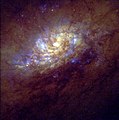NGC 1808
| Galaxie NGC 1808 | |
|---|---|
 | |
| Aufnahme mithilfe des Víctor M. Blanco Telescope | |
| AladinLite | |
| Sternbild | Taube |
| Position Äquinoktium: J2000.0, Epoche: J2000.0 | |
| Rektaszension | 05h 07m 42,3s [1] |
| Deklination | −37° 30′ 47″ [1] |
| Erscheinungsbild | |
| Morphologischer Typ | (R'_1)SAB(s:)b Sy2[1] |
| Helligkeit (visuell) | 9,9 mag[2] |
| Helligkeit (B-Band) | 10,8 mag[2] |
| Winkelausdehnung | 6,5′ × 3,9′[2] |
| Positionswinkel | 133°[2] |
| Flächenhelligkeit | 13,3 mag/arcmin²[2] |
| Physikalische Daten | |
| Zugehörigkeit | NGC-1808-Gruppe, LGG 127[1][3] |
| Rotverschiebung | 0.003339 ± 0.000013[1] |
| Radialgeschwindigkeit | (1001 ± 4) km/s[1] |
| Hubbledistanz H0 = 73 km/(s • Mpc) | (37 ± 3) · 106 Lj (11,4 ± 0,8) Mpc [1] |
| Durchmesser | 70.000 Lj[4] |
| Geschichte | |
| Entdeckung | James Dunlop |
| Entdeckungsdatum | 10. Mai 1826 |
| Katalogbezeichnungen | |
| NGC 1808 • PGC 16779 • ESO 305-008 • MCG -06-12-05 • IRAS 05059-3734 • 2MASX J05074234-3730469 • SGC 050559-3734.6 • AM 0505-373 • GC 1021 • h 2740 • Dun 549 • LDCE 0384 NED002 | |
NGC 1808 ist eine Balkenspiralgalaxie im Sternbild Taube, die etwa 37 Millionen Lichtjahre von der Milchstraße entfernt ist. NGC 1808 ist eine Starburstgalaxie mit heftiger Sternentstehung in ihrem Zentralbereich.
Das Objekt wurde am 10. Mai 1826 von dem schottischen Astronomen James Dunlop entdeckt.[5]
- Abbildung der Struktur des Staubs und des ionisierten Wasserstoffs im zentralen Bereich mithilfe des Hubble-Weltraumteleskops
- Das Zentrum aufgenommen vom Hubble-Weltraumteleskop
NGC 1808-Gruppe (LGG 127)
| Galaxie | Alternativname | Entfernung / Mio. Lj |
|---|---|---|
| NGC 1808 | PGC 16779 | 37 |
| NGC 1792 | PGC 16709 | 46 |
| NGC 1827 | PGC 16849 | 38 |
| PGC 16790 | ESO 305-9 | 38 |
| PGC 16976 | ESO 305-17 | 40 |
| PGC 17027 | ESO 362-11 | 52 |
| PGC 17157 | ESO 362-19 | 50 |
Einzelnachweise
Weblinks
- NGC 1808: A Nearby Starburst Galaxy – Astronomy Picture of the Day vom 1. Juli 1998 (englisch).
- Starbirth in NGC 1808 – Astronomy Picture of the Day vom 23. März 1998 (englisch).
- The Starburst Galaxy 1808
- HST imaging of the startburst galaxy 1808
- CDS Portal
Auf dieser Seite verwendete Medien
Autor/Urheber: Fabian RRRR, Lizenz: CC BY-SA 3.0
Color rendering is done by by Aladin-software (2000A&AS..143...33B.)
Autor/Urheber: Dark Energy Survey/DOE/FNAL/DECam/CTIO/NOIRLab/NSF/AURA, Lizenz: CC BY 4.0
NGC 1808 is a barred spiral galaxy located in the southern constellation Columba (the dove). This image was captured using the Dark Energy Camera (DECam), which is mounted on the Víctor M. Blanco 4-meter Telescope at Cerro Tololo Inter-American Observatory (CTIO), a Program of NSF’s NOIRLab, in Chile. The core of NGC 1808 is thought to house a supermassive black hole, characterized by its accretion of material and higher-than-normal brightness. The smoldering center is closely surrounded by a faint blue ring populated with star clusters and supernova remnants. This region is defined by its starburst activity, producing an exceptional number of hot, bright, young stars. The abundance of rapid star formation is thought to be the result of past tidal interactions with the nearby galaxy NGC 1792. Laced throughout this middle region of NGC 1808 are dark dust lanes resulting from large outflows of hydrogen gas from the galactic nucleus. The softly glowing outer arms surrounding the galaxy are slightly warped, again pointing to tidal interactions with NGC 1792. Such an interaction could have created the asymmetrical shape of NGC 1808 and hurled gas towards the nucleus, igniting the rapid star formation in its surrounding ring.You can find a square view of this Image of the Week here.Image processing: R. Colombari and M. Zamani (NSF’s NOIRLab)
The Center of NGC 1808




